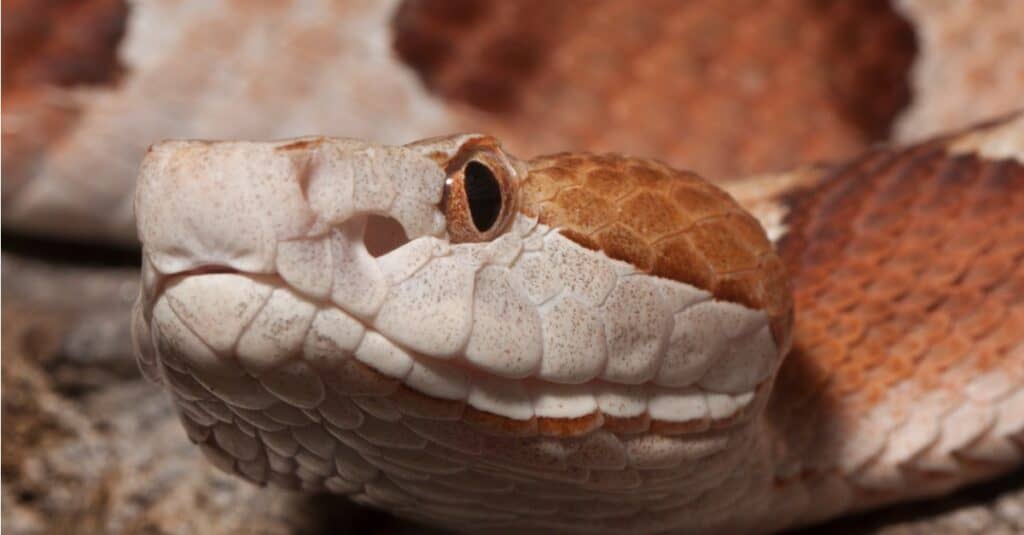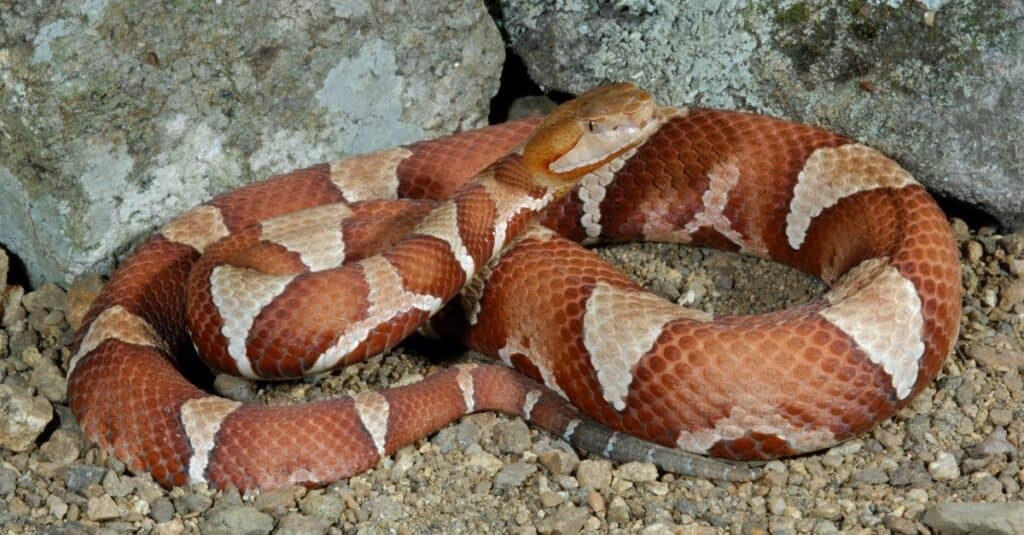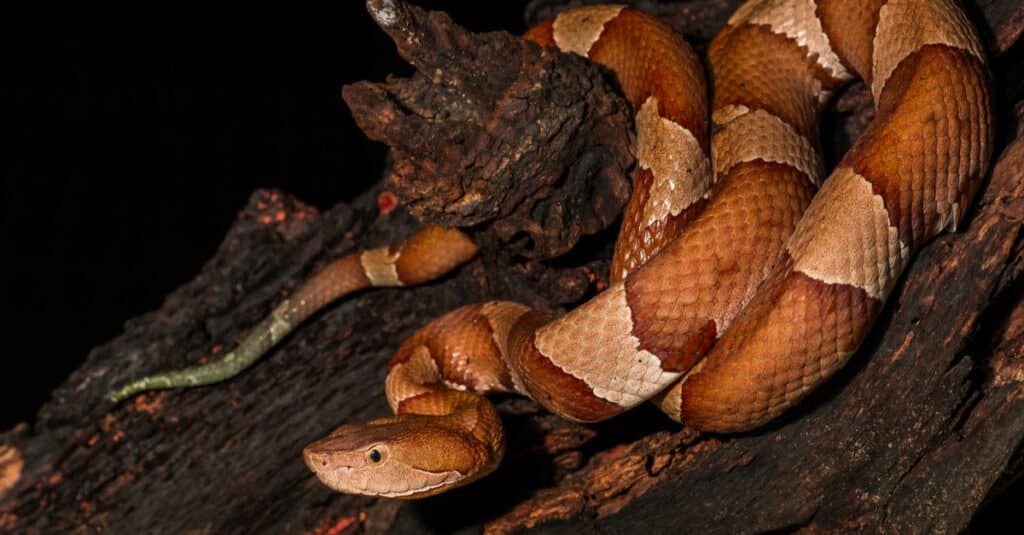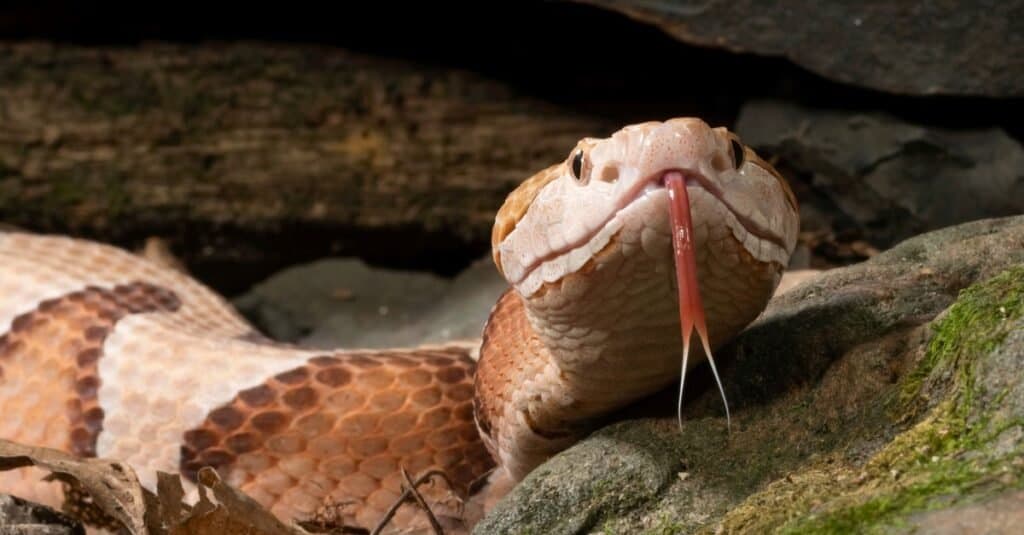42 species of snakes call Kansas home. Of those species, only four are venomous. These include copperheads, prairie rattlesnakes, timber rattlesnakes, and massasauga rattlesnakes. Copperheads are the least worrisome of all the snakes in Kansas; their bites are generally not life-threatening, and they’re non-aggressive. They may be common, but copperheads in Kansas are nothing if not reclusive and shy.
Here, we’ll learn more about copperhead snakes in Kansas. We’ll focus on where they live and how likely they are to bite. But, we’ll also learn more about this species as a whole, what they look like, how big they get, and what they do. Then, we’ll learn about the proper actions you should take if you run into a copperhead in Kansas.
Copperhead: Background

These snakes are venomous members of the pit viper family, which also includes rattlesnakes and lanceheads.
©iStock.com/Mark Kostich
Copperhead snakes are plentiful in Kansas. There are actually two subspecies of copperheads in Kansas, the eastern copperhead (Agkistrodon contortrix) and the broad-banded copperhead (Agkistrodon laticinctus). However, the two species interbreed and hybridize throughout the state.
Copperheads are small snakes that grow no larger than 40 inches. Their base color is tan to orange, with hourglass-shaped markings. These snakes eat small creatures and only attack humans in self-defense. Because of their stable population, copperheads are listed as Least Concern. Like many snakes, copperheads do not lay eggs. Instead, they give birth to live young.
Appearance
As pit vipers, copperheads have heat-sensing pits located just behind their nostrils. Their eyes are yellow, with vertically elliptical pupils. Copperhead heads are triangular and broad at the base to make room for the large venom glands behind the eyes.
Copperheads get their name from their distinct copper coloring, which can range from light tan to pink tan. Their bellies are lighter in color. One of the most distinguishing features of the copperhead is its hourglass-shaped markings. These markings extend from one side of the body to the other over the back; they’re darker than the rest of the body.
Baby cottonmouths look just like adults, except for one difference: their tails. Young copperheads in Kansas have bright green or yellow tails, making them easy to distinguish from adults.
Size

As with many species of snake, male copperheads are smaller than female copperheads.
©Breck P. Kent/Shutterstock.com
Typical copperheads grow to be between 20-35 inches long. Rarely, individuals grow to 40 inches long. They have slender bodies, with adults weighing less than a pound. This makes them one of the smallest venomous snakes in Kansas.
Behavior
Copperheads eat insects, small mammals, and reptiles. Their prey includes cicadas, grasshoppers, mice, lizards, small snakes, voles, rats, salamanders, squirrels, and caterpillars. Copperheads are ambush predators and spend most of their time lying in wait for prey. For most of the year, they’re diurnal (active in the day), but during the peak of summer, they shift to nocturnal hunting.
Copperheads may be scary, but they’re highly unlikely to attack humans. This is because when copperheads in Kansas are threatened, they freeze and hide, rather than attack. Unlike other snakes, copperheads don’t flee either. Because of this, they’re most likely to be encountered hiding in bushes or under rocks.
Habitat and Range

Copperheads are common snakes throughout many parts of North America.
©Wildvet/Shutterstock.com
Copperheads are habitat generalists and live in a variety of habitats. They’re usually found in rocky areas with woods or meadows nearby. Because of their secretive nature, copperheads prefer rocky outcroppings and crevices. They’re often found in the same areas as rattlesnakes and rat snakes. Occasionally, copperheads in Kansas also occur near water sources, like lakes, rivers, and swampy areas.
Where do Copperheads Live in Kansas?
Copperhead snakes in Kansas are most likely to be encountered under bushes or in rocky areas. Females give birth to babies in August, September, and October; young snakes are most likely to be encountered in those months. Copperheads in Kansas can be found all over the state, but are more populous in the eastern side. They’re particularly fond of grasslands and the edge zones between forest and meadow.
Do Copperheads in Kansas Bite?

Copperheads venom lacks potency and is not life-threatening.
©Joe McDonald/Shutterstock.com
Copperheads in Kansas only rarely bite people. That’s because these snakes are small, shy, and nonaggressive; they would rather remain hidden than have to bite a person. Bites almost always happen when a human happens upon a copperhead by accident, when poking around in bushes or rocky areas that the copperhead calls home.
Fortunately, most copperhead bites are ‘dry’ bites, meaning no venom is injected. However, if you are bitten by a copperhead, you should always seek immediate medical attention and antivenom. There is absolutely no need to capture or kill the snake that bit you. Since all of Kansas’s venomous snakes are pit vipers, all bites receive the same antivenom.
Copperheads have relatively weak venom. In healthy adults, there is little chance of serious complications. However, young children, elderly people, and those with compromised immune systems are at greater risk from the copperhead’s venom. It is especially important that they receive prompt medical care and antivenom in case of a bite.
What to Do if You See a Copperhead in Kansas
Let’s say you’re out and about, hiking, camping, or maybe just walking around the neighborhood, and you see a copperhead. What do you do? Remember, if you see copperheads in Kansas, leave them alone. Like all wildlife, copperheads will defend themselves if necessary. Treat them with respect and caution. Never approach or try to harm or capture a copperhead snake. In fact, most bites happen when people try to handle, harass, or even kill these incredible creatures.
The photo featured at the top of this post is © iStock.com/David Kenny
Discover the "Monster" Snake 5X Bigger than an Anaconda
Every day A-Z Animals sends out some of the most incredible facts in the world from our free newsletter. Want to discover the 10 most beautiful snakes in the world, a "snake island" where you're never more than 3 feet from danger, or a "monster" snake 5X larger than an anaconda? Then sign up right now and you'll start receiving our daily newsletter absolutely free.
Thank you for reading! Have some feedback for us? Contact the AZ Animals editorial team.






